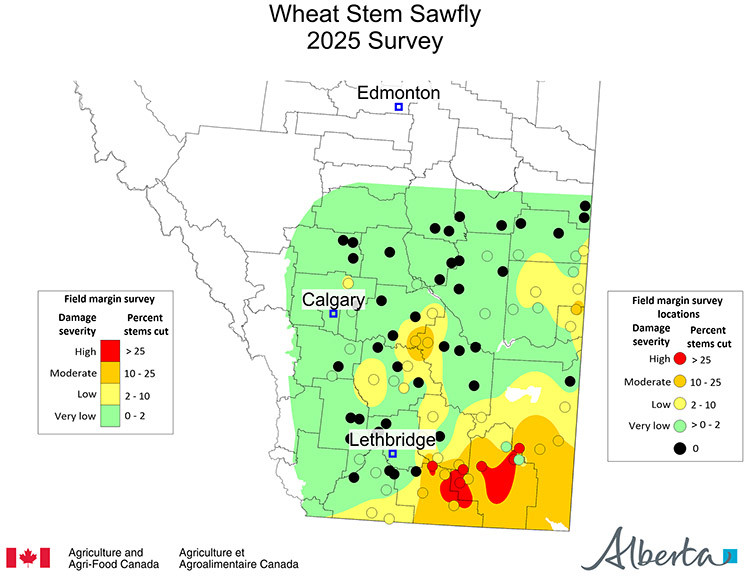Government mail service may be affected by the Canada Post labour disruption. Learn about how critical government mail will be handled.
This is not a forecast. It is a summary of the wheat stem sawfly situation in Alberta in fall 2025.
Overview
The area affected by sawfly cutting damage in 2025 has continued to decrease in Alberta. We are still seeing moderate to high cutting percentages in the traditional sawfly areas. The random nature of the survey means that individual fields may have higher wheat stem sawfly populations than are indicated in the survey map.
Producers are aware of sawfly in their fields. Cutting levels of 10 to 15% or higher in the previous crop year indicate the need to consider planting non-host broad-leaf crops, oats, or solid-stem varieties to reduce sawfly losses. The risk in the traditional wheat stem sawfly areas still continues in 2026.
Methodology
The wheat stem sawfly survey is an after-harvest survey completed in the fall of 2025. The population map is based on 92 fields in 22 municipalities across southern Alberta and the municipalities along the Saskatchewan – Alberta border as far north as Bodo (MD of Provost).
In each field, the number of stems cut by wheat stem sawfly and the number of uncut stems is counted in one metre of stubble in 4 locations along the headland. The percentage of cut stems is then determined.
2025 survey findings
Field locations denoted by a black dot had zero sawfly found in the survey. While the overall area impacted by sawfly cutting decreased in 2025, the severity of damage increased slightly in Forty Mile and Warner Counties.
The percentage of stems cut by sawfly gives an indication of the number of reproductive adult sawflies that will emerge in late June through early July. Winter conditions have very little impact on sawfly populations and a high proportion of wheat stems cut in the fall will produce adults.
Female sawflies lay eggs inside grass and grassy crop stems, the eggs hatch and tunnel inside stems until the crop starts to dry down near harvest. As the crop starts to ripen the sawfly larva migrates to the stem base and cuts a notch most of the way through the stem, wind or wet weather cause the cut stems to break and the heads to fall to the ground. Feeding damage from the tunneling can result in hidden yield losses of 10 to 15% in each stem affected. Further yield losses occur from lodging at harvest.
It is possible that population hot spots still exist in areas of lower risk, producers need to be aware of the potential risks in their own fields. Cutting levels of 10 to 15% or higher in the previous crop year indicate the need to consider planting non-host broad-leaf crops or oats to reduce sawfly losses. When populations are low it is typical to have small, localized populations of sawfly that affect only one field or even just a portion of one field. At lower populations, wheat stem sawfly also tends to have a very strong edge effect where they migrate into the current year crop from the previous year stubble.
Parasitism can reduce populations and reduce the level of cutting. A parasitic wasp, Bracon cephi, has been shown to have significant impact on sawfly populations. The use of solid stem wheat varieties and the increase in parasitism are the major factors that lower sawfly populations in Alberta.
Acknowledgements
The 2025 survey was completed by Agriculture and Irrigation, Plant and Bee Health Surveillance Section staff.
Thanks to Jon Williams, Agriculture and Agri-Food Canada, for building the map.
Historical survey maps
- 2024 Survey Map
- 2023 Survey Map
- 2022 Survey Map
- 2021 Survey Map
- 2020 Survey Map
- 2019 Survey Map
- 2015 Survey Map
- 2014 Survey Map
- 2013 Survey Map
- 2012 Survey Map
- 2011 Survey Map
- 2010 Survey Map
- 2009 Survey Map
